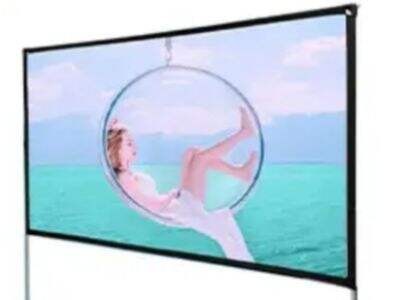Əgər çox böyük ekranlı film və ya proqram izləmək istəyirsizsə, Projeksiya Ekrani ideal variantdır. Yaxşı bir projeksiya ekranı açıq şəkilə malik ola bilər ki, bu da izləməni daha maraqlı və eğləncəli edir. Orada mövcud olan müxtəlif növü ekranların sizi hansı uyğun olduğunu anlamağa kömək edir. Biz sizə kömək edək və ən uyğun ev və ya iş üçün projeksiya ekranını seçməyinizə kömək edəcək əsas məlumatları nəzərə alınız.
Fərqli Növ Proyeksiya Ekranlarına Dair Rehber
Proyeksiya ekranlarının çoxu fərqli növləri var və xüsusiyyətləri itibarilə unikaldırlar. Burada ən ümumilərindən bəziyləri ilə tanışlaşacaqsınız:
Sabit Çerçivə Ekranları: Çerçivəyə bağlı ekran və yuvarlana bilməz və ya qatlanıb saxlanılmayır. Onlar şəkilləri daha dəqiq və açıq görünməsinə kömək edir. Ancaq bu növ ekranlar sadəcə ev sinemaları üçün və ya filmləri çox sıradan izlədiyiniz yerlər üçün yaxşıdır.
Əl ilə aşağı çəkilməli ekranlar: Bu, onları istifadə etmək istədiyiniz zaman aşağı çəksiniz kimi mekanizmlərlə idarə olunur. Projek tor çox sadədir və çox pahalı deyil. Bunlarda hala bəzi kövrəklər və ya qatlıqlar ola bilər ki, bu da şəkilçinin keyfiyyətini təsir edə bilər. Bu, yalnız maliyyəni zədəlməyəcək bir həllə ehtiyac duyan insanlar üçün çox uyğundur.
Elektrikli Ekranlar: Bu ekranlara motor eşlik edir. Uzaktan komandaya və ya düyməyə basaraq, ekranı istədiyiniz istiqamətdə hərəkət ettirə bilərsiniz. Lakin, daha böyük sistemlərlə işlədikcə xüsusilə yaxşı işləyən çox rahat bir həllə malikdirlər. Onların qiyməti daha yüksəkdir və düzgün quraşdırılması üçün professional köməkə ehtiyacı olacaqdır. Belə bir ekran, rahatlıq və yüksək təsvir keyfiyyətinə səhvənəmir olan insanlar üçün idealdir.
Seyahət Ekranları: Bu ekranlar portativ və çoxsağlam olaraq təyin edilib, evlər arasında və ya qısa müddətlik yerlər arasında köçürülən üçün mükəmməldir. Onları asanlıqla hər hansı yerdə yerləşdirmək olar. Amma, bu növ ekranlar digər ekran növlərindən daha az dayanıqlıdır və uzun müddət saxlanılmır. Bu növ insanın şəxsi hadisələrə iştirak etdiyi və ya ekranı bir yerden başqa köçürməli olduğu halda idealdir.
Proyeksiya Ekranı Seçərkən Nəzərdə Tutulmalı Faktorlar
Proyeksiya ekranı və proyektor seçərkən əhəmiyyətli bir çox şey nəzərə alınmalıdır. Burada nəzərə almalığınız bəzi əsas nüqtələr verilmiştir:
Ekran Ölçüsü: Lazım olan ekran ölçüsünü otaqınızın ölçülərinə, proyektorun ekranınızdan neçə uzaqda olduğunuza və şəxsi istəklərinizə görə seçirsiz. Daha çox fəaliyyət və detallar gözləyə bilərsiniz, lakin istifadə etdiyiniz proyektor uyğun və məqsədə uyğun olmalıdır ki, lazımi nəticəni əldə edəsiniz. Ekranınızın istifadə etdiyiniz sahədə gözəl yerləşəcəyi ümid edirsiniz.
Qazanc: Ekranın işıqı ümumiyyətlə qaytarmağa qabiliyyəti. Belə bir yüksək-qazançlı ekran, şəkilləri səyahət etdikcə daha aydın görünməyə imkan verir ki, bu yaxşı əhəngləndirilmiş otaqlar üçün uyğundur. Amma yüksək qazanc da istifadəçi üçün sual olaraq ən çox gözlərin təsiri və ya rəng distorsiya yarada bilər; hər iki dəstəkdən biri də şəkil keyfiyyətindən azaldılabilir. Çevrilməniz üçün işləyən bərabərlik tapmaq əsasdır.
Görüş burcu: Görüş burcu, şəkil pis başlayana qədər ekranınızdan neçə uzaq oturacağınızı təyin edir. Geniş görüş burcları birdəfəliklərlə birlikdə izləmək üçün yaxşıdır, amma açıq görünürlük üçün daha yaxşı keyfiyyətli ekran lazımdır. Nəzərdə tutulan nəzarətçilərin sayını və yerləşmə formalarını nəzərə almalısınız.
Çevrə işıqlığı: proyeksiya ekranı və proyektor otağınızda olan işıqlandırma səviyyəsi, ekranınızda olan şəkil keyfiyyətində əhəmiyyətli bir faktordur. Əgər birdənə çox pəncərə və ya çətin işıqlarınız varsa, ekran üzərinə daha yüksək qazance və ya daha qara rəng seçə bilərsiniz. Bu, gün əvvəl film izləmək istəyirsinizsə xüsusilə vacibdir, çünki bu zaman çox sıxşın shine.
Ekranınız üçün uyğun nisbəti necə seçməliksiniz?
Beləliklə, ekran nisbəti, ekran eni ilə onun uzunluğuna nisbətdir. Burada sizin mövcud ekran nisbətlərindən bəziləri var və onlar haqqında məlumat sahibi olursa, hansı ekran alacağınızı seçməkdə kömək edə bilər:
4:3 Nisbət: Bu, daha kəskin formatdır. Daha qədim TV-lərdə və kompüter monitorlarında əks etdirilib. Bu, bəzi videolar üçün işləbilər, amma geniş ekranlı film üçün yaxşı deyil, deyil mi?
16:9 Nisbət Oranı: Bu, HDTV və DVD-lər üçün istifadə olunan daha ümumi geniş ekranda formatlardan biridir. Bu da daha sinema hissi yaradır və bütün növ filmləri və proqramları izləmək üçün çox yaxşıdır. Beləliklə, əksər mövzular bu nisbət orana uyğun olduğundan, bu da çox populyar seçimdir.
2.35:1 Nisbət Oranı: Bu isə bəzi filmlər üçün istifadə olunan başqa bir ultra geniş formatdır. Bu sizə daha şəxsi təcrübə verir, çünki hərəkət hissindən hissə olmağınız kimi olacaqsınız. Bununla belə, bəzı məzmunlar üçün siyah çubuqlar və ya qırılma ola bilər, beləcə duruluşda nəzərə almalısınız.
 EN
EN
 AR
AR
 HR
HR
 NL
NL
 FR
FR
 DE
DE
 IT
IT
 JA
JA
 PL
PL
 RU
RU
 ES
ES
 SV
SV
 TL
TL
 ID
ID
 LT
LT
 SR
SR
 SK
SK
 UK
UK
 VI
VI
 MT
MT
 TH
TH
 TR
TR
 FA
FA
 MS
MS
 GA
GA
 AZ
AZ
 KA
KA
 LA
LA
 MN
MN
 MY
MY
 KK
KK
 UZ
UZ
 KY
KY
 LB
LB


